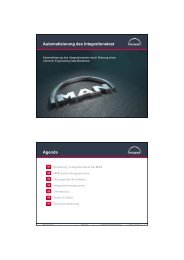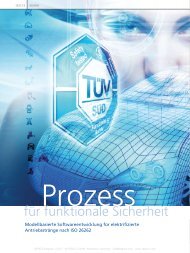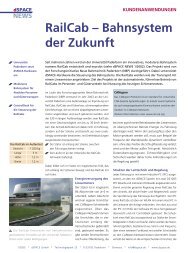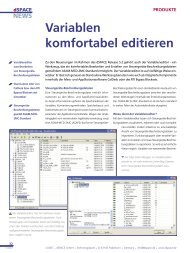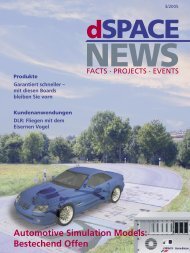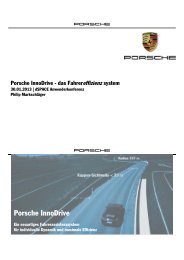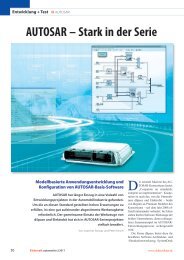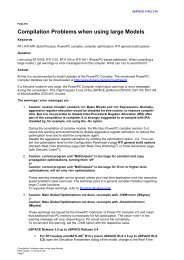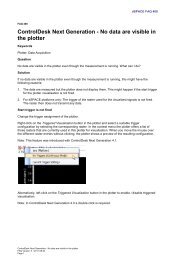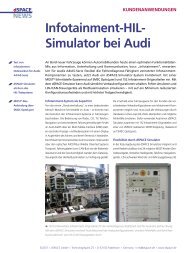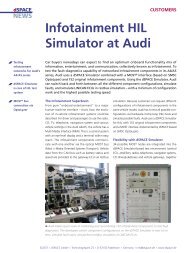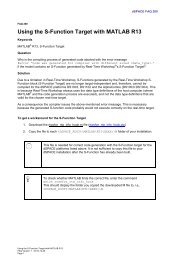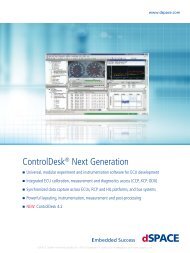magazinE - dSPACE
magazinE - dSPACE
magazinE - dSPACE
Create successful ePaper yourself
Turn your PDF publications into a flip-book with our unique Google optimized e-Paper software.
Transparent and Safe modeling<br />
The new MISRA guidelines for<br />
TargetLink contain requirements for<br />
modeling with regard to functional<br />
safety and are particularly relevant to<br />
safetycritical projects. They reflect<br />
the greatly increased importance of<br />
modelbased design and automatic<br />
production code generation. The<br />
main issues covered are:<br />
n Avoiding specific modeling elements<br />
and modeling styles in<br />
MATLAB ® /Simulink ® /Stateflow ®<br />
for reasons of functional safety<br />
n Modeling elements that support a<br />
transparent model structure to<br />
simplify model reviews<br />
Interview<br />
with Michael Beine,<br />
TargetLink Product Manager<br />
(<strong>dSPACE</strong>)<br />
n Instructions on specifying implementation<br />
information to ensure<br />
that the generated C code complies<br />
with a maximum number of<br />
MISRA C:2004 guidelines<br />
The new MISRA guidelines for<br />
TargetLink are available at the official<br />
MISRA Web site, www.misra.org.uk<br />
(“MISRA AC TL – Modelling style<br />
guidelines for the application<br />
of TargetLink in the context of<br />
automatic code generation“).<br />
new Version of the dSPaCE<br />
modeling guidelines for<br />
TargetLink<br />
In addition to the MISRA TargetLink<br />
guidelines, TargetLink users can also<br />
Mr. Beine, could you briefly explain<br />
the practical significance of the new<br />
MISRA guidelines for TargetLink<br />
users?<br />
Imagine you want to model a vehicle<br />
function in Simulink ® /TargetLink and<br />
then implement it as production<br />
code. How do you make sure, for<br />
example, that the generated code is<br />
sufficiently compliant with the<br />
MISRA C guidelines and suitable for<br />
code reviews, yet still fits the limited<br />
resources available on the ECU?<br />
Do you always know precisely<br />
whether the modeling constructs you<br />
use are transparent in Simulink ® /<br />
Stateflow ® and have no hidden<br />
pitfalls? The MISRA modeling guidelines<br />
for TargetLink give you useful<br />
tips and instructions that will benefit<br />
your production projects.<br />
What do the guidelines mean for<br />
TargetLink as a product, which after<br />
all has been on the market for many<br />
years?<br />
We’re very pleased that the MISRA C<br />
guidelines, which are widely used at<br />
code level, are now supplemented<br />
refer to <strong>dSPACE</strong>’s own modeling<br />
guidelines, the latest version of<br />
which is 2.1. These guidelines are an<br />
ideal supplement to the MISRA<br />
TargetLink guidelines and the MAAB<br />
guidelines (MathWorks Automotive<br />
Advisory Board). The <strong>dSPACE</strong><br />
TargetLink Guidelines are available<br />
on request from <strong>dSPACE</strong> Sales.<br />
They are also available online as part<br />
of the eGuidelines:<br />
http://www.eguidelines.de.<br />
Please note:<br />
MISRA does not endorse or make recommendations<br />
for any specific manufacturers,<br />
their products, or services.<br />
by the MISRA TargetLink guidelines at<br />
model level. The MISRA TargetLink<br />
guidelines show that TargetLink is<br />
firmly established as the defacto<br />
standard for autocoding in the automotive<br />
sector. Production applications<br />
using TargetLink can be found in all<br />
automotive domains such as powertrain,<br />
body electronics, chassis, driver<br />
assistance systems, vehicle safety, and<br />
even infotainment. The TargetLink<br />
modeling guidelines from MISRA give<br />
TargetLink users additional support in<br />
these applications, especially with<br />
regard to functional safety. Incidentally,<br />
<strong>dSPACE</strong> also provides its own<br />
TargetLink modeling guidelines,<br />
which cover further aspects such as<br />
AUTOSAR and achieving maximum<br />
code efficiency.<br />
Thank you for talking to us,<br />
Mr. Beine.<br />
pAGe 47



